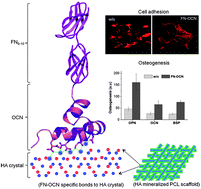Tethering bi-functional protein onto mineralized polymer scaffolds to regulate mesenchymal stem cell behaviors for bone regeneration
Abstract
Modifying three-dimensional scaffolds with bioactive extracellular

* Corresponding authors
a
Institute of Tissue Regeneration Engineering (ITREN), Dankook University, South Korea
E-mail:
kimhw@dku.edu
Fax: +82 41 550 3085
Tel: +82 41 550 3081
b Department of Nanobiomedical Science and WCU Research Center, Dankook University Graduate School, South Korea
c Department of Biochemistry, College of Medicine, Inha University, South Korea
d The Faculty of Pharmacy, The University of Sydney, NSW 2006, Australia
e Department of Biochemical Engineering, University College London, Torrington Place, London, UK
f Department of Biomaterials Science, School of Dentistry, Dankook University, South Korea
Modifying three-dimensional scaffolds with bioactive extracellular

 Please wait while we load your content...
Something went wrong. Try again?
Please wait while we load your content...
Something went wrong. Try again?
J. H. Lee, J. Park, Y. Yun, J. Jang, E. Lee, W. Chrzanowski, I. B. Wall and H. Kim, J. Mater. Chem. B, 2013, 1, 2731 DOI: 10.1039/C3TB00043E
To request permission to reproduce material from this article, please go to the Copyright Clearance Center request page.
If you are an author contributing to an RSC publication, you do not need to request permission provided correct acknowledgement is given.
If you are the author of this article, you do not need to request permission to reproduce figures and diagrams provided correct acknowledgement is given. If you want to reproduce the whole article in a third-party publication (excluding your thesis/dissertation for which permission is not required) please go to the Copyright Clearance Center request page.
Read more about how to correctly acknowledge RSC content.
 Fetching data from CrossRef.
Fetching data from CrossRef.
This may take some time to load.
Loading related content
